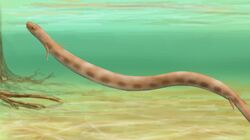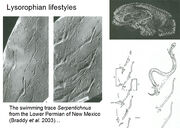| Lysorophians Fossil range: Carboniferous - Permian | |
|---|---|
 Brachydectes newberryi | |
| Scientific classification
| |
|
Superclass |
|
|
Class |
|
|
Subclass |
|
|
Order |
Lysorophia |
|
Family |
Lysorophidae |
| |
Lysorophia are an order of aquatic Carboniferous and Permian amphibians, which supericially resembled small snakes.
Description[]

The lifestyles of lysorophians.
Lysorophians had strongly reduced limbs and limb girdles and elongate skulls, typically with a strongly emarginated cheek region. Trace fossils suggest that some species were aquatic sidewinders,[1] and others seem to have estivated at the bottom of burrows.[2] Lysorophians have been regarded by some paleontologists as derived nectrideans allied to aïstopods, but others find them outside of a clade that includes nectrideans, aïstopods and others.[3]
The skull is lightly built and open, with large orbits and fenestrae. The intertemporal, supratemporal, postfrontal, and jugal bones of the skull have disappeared. The mandibles are short, and the maxilla and premaxilla freely movable.
The torso is very elongate, the limbs diminutive or absent, and the tail short. There are up to 99 pre-sacral (i.e. not including the hips and tail) vertebrae.
Based on morphology of the cranio-vertebral articulation, Lysorophids are usually related to the Microsauria, although the pattern of bones of the skull is very different.
There is a single family, the Lysorophidae. The group is known mainly from the Late Pennsylvanian and Early Permian of North America.
References[]
- Carroll, RL (1988), Vertebrate Paleontology and Evolution, WH Freeman & Co. p.180
- Wellstead, C.F. (1991), Taxonomic revision of the Lysorophia, Permo-Carboniferous lepospondyl amphibians. Bull. Am. Mus. Nat. Hist. 209:1–90
- von Zittel, K.A (1932), Textbook of Paleontology, C.R. Eastman (transl. and ed), 2nd edition, vol.2, p.225-6, Macmillan & Co.
External links[]
- ^ Braddy, S. J., Morrissey, L. B. & Yates, A. M. 2003. Amphibian swimming traces from the Lower Permian of southern New Mexico. Palaeontology 46, 671-683.
- ^ Olson E. C. 1971. A skeleton of Lysorophus tricarinatus (Amphibia: Lepospondyli) from the Hennessey Formation (Permian) of Oklahoma. Journal of Paleontology 45, 443-449.
- ^ Ruta, M., Coates, M. I. & Quicke, D. L. J. 2003. Early tetrapod relationships revisited. Biological Reviews 78, 251-345.